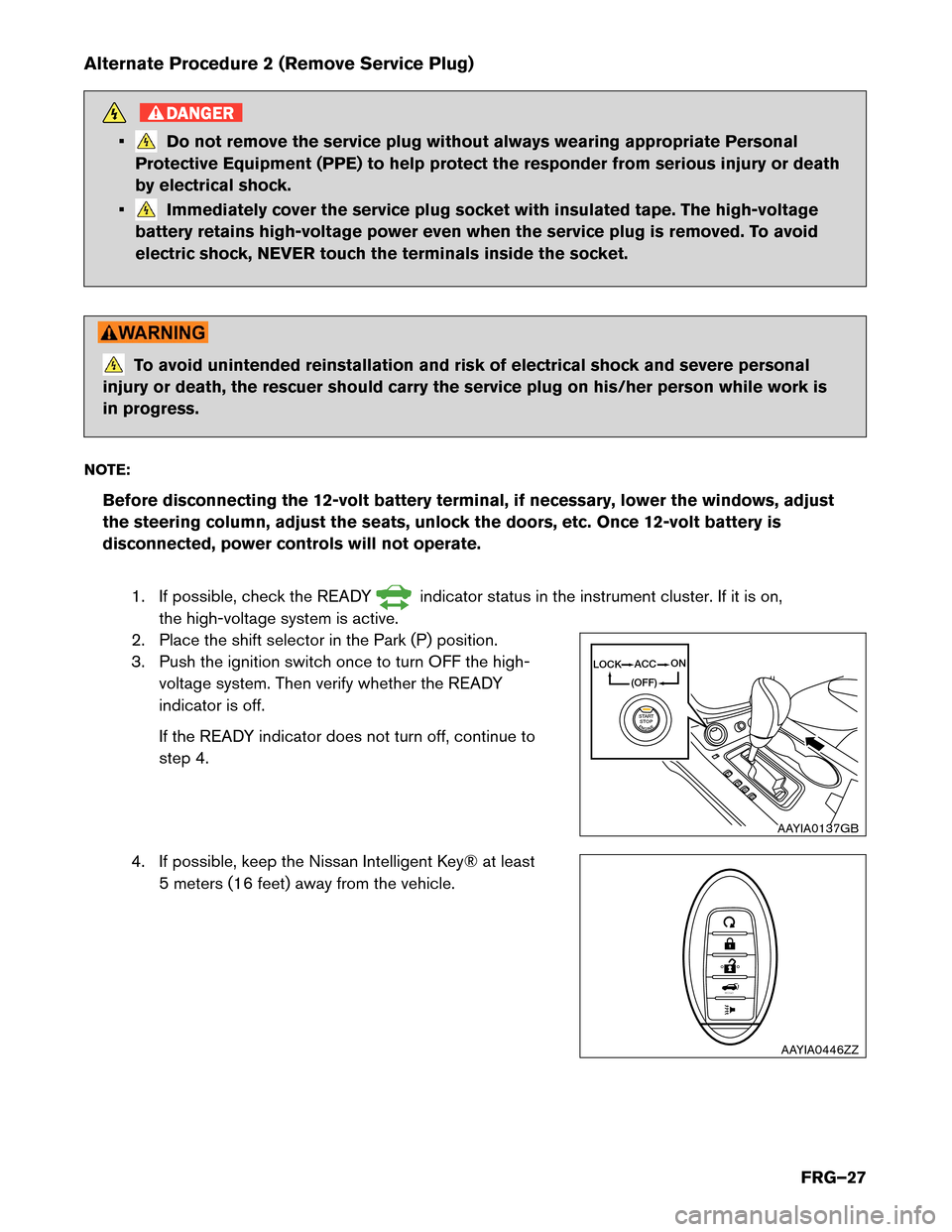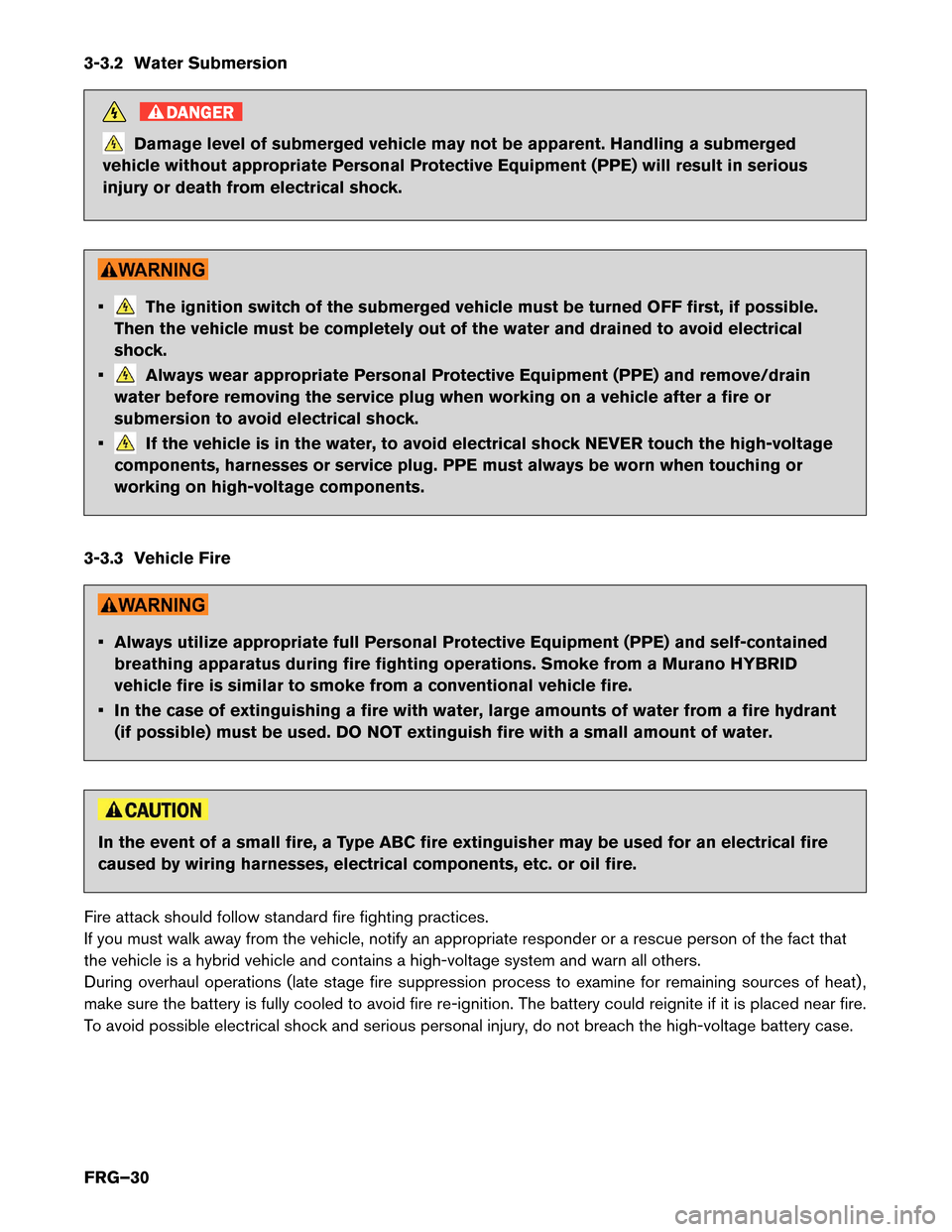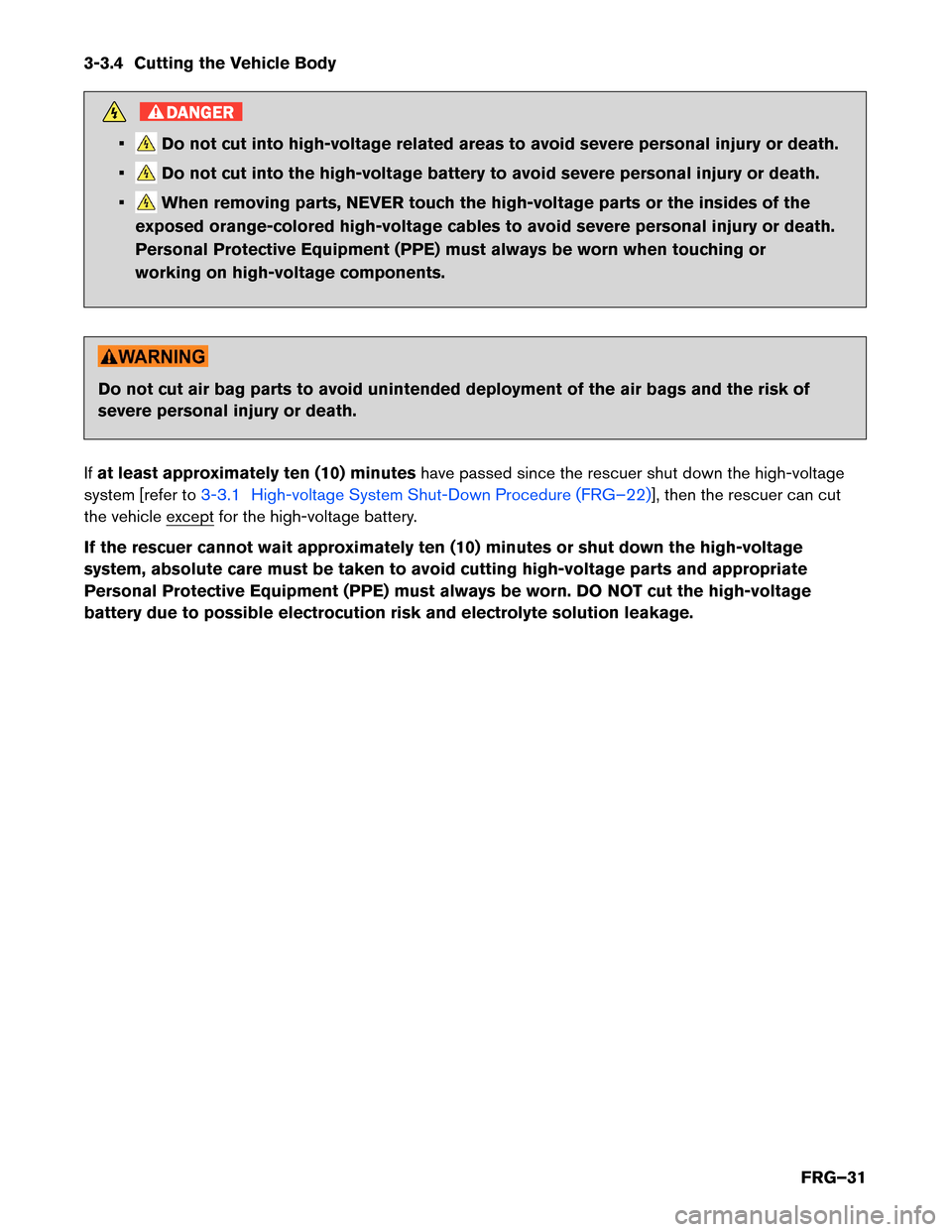Page 25 of 44
Alternate Procedure 1 (Remove Fuses)
NO
TE:
Before removing any fuses, if necessary, lower the windows, adjust the steering column,
adjust the seats, unlock the doors, etc. Once fuses are removed, power controls will not
operate.
1. Pull release handle located on the instrument panel and push the release lever under the hoodsideways to open hood.
2. Release clips on the narrow ends of the fuse box cover and remove it. : Vehicle front AAYIA0422ZZ
AAYIA0154GB
FRG–25
Page 26 of 44
3. Remove IGCT RLY fuse (F/L IGCT RLY 50A) .
4.
If you cannot identify the correct fuse, remove all the
fuses. To avoid unintended reinstallation and risk of
electrical
shock and severe personal injury or death, the
rescuer should carry the fuse or fuses on his/her person
and cover the fuse box with insulated tape.
5. Remove traction motor inverter cover.
6. Disconnect negative (-) battery cable and cover it withinsulated tape.
7. Wait approximately ten (10) minutes for complete discharge of the high-voltage capacitor
after the fuse panel and battery cable have been disconnected.
8. Perform the first response action. F/L IGCT RLY 50A
(Red)
AAYIA0154GB
AAYIA0447ZZ
AAYIA0274ZZ
FRG–26
Page 27 of 44

Alternate Procedure 2 (Remove Service Plug)
DANGER
• Do not remove the service plug without always wearing appropriate Personal
Protective Equipment (PPE) to help protect the responder from serious injury or death
by electrical shock.
• Immediately cover the service plug socket with insulated tape. The high-voltage
battery
retains high-voltage power even when the service plug is removed. To avoid
electric shock, NEVER touch the terminals inside the socket. To avoid unintended reinstallation and risk of electrical shock and severe personal
injury
or death, the rescuer should carry the service plug on his/her person while work is
in progress.
NOTE: Before disconnecting the 12-volt battery terminal, if necessary, lower the windows, adjust
the steering column, adjust the seats, unlock the doors, etc. Once 12-volt battery is
disconnected, power controls will not operate.
1. If possible, check the READY indicator status in the instrument cluster. If it is on,
the
high-voltage system is active.
2. Place the shift selector in the Park (P) position.
3. Push the ignition switch once to turn OFF the high- voltage system. Then verify whether the READY
indicator is off.
If the READY indicator does not turn off, continue to
step 4.
4. If possible, keep the Nissan Intelligent Key® at least 5 meters (16 feet) away from the vehicle.
PR N
D ACC
ENGINESTART
STOP LOCK
(OFF)
ON
AAYIA0137GB
HOLD AAYIA0446ZZ
FRG–27
Page 28 of 44
5. Open the center console and use a suitable tool to remove the service plug access cover.
6.
Remove the service plug (A)by pulling the locking lever (B), then pressing the locking tab (C)
and rotating the handle (D)fully outward. Using the handle, pull the service plug (E)completely
out of its socket.
7. Wait approximately ten (10) minutes for complete discharge of the high-voltage capacitor
after the service plug has been removed. AAYIA0448ZZ
A B C
D E
AAYIA0450ZZ
FRG–28
Page 29 of 44
8. Pull release handle located on the instrument panel and push the release lever under the hood
sideways to open hood.
9. Remove traction motor inverter cover.
10. Disconnect negative (-) battery cable and cover it with insulated tape.
11. Perform the first response action. AAYIA0422ZZ
AAYIA0447ZZ
AAYIA0274ZZ
FRG–29
Page 30 of 44

3-3.2 Water Submersion
DANGER
Damage level of submerged vehicle may not be apparent. Handling a submerged
vehicle without appropriate Personal Protective Equipment (PPE) will result in serious
injury or death from electrical shock. • The ignition switch of the submerged vehicle must be turned OFF first, if possible.
Then
the vehicle must be completely out of the water and drained to avoid electrical
shock.
• Always wear appropriate Personal Protective Equipment (PPE) and remove/drain
water
before removing the service plug when working on a vehicle after a fire or
submersion to avoid electrical shock.
• If the vehicle is in the water, to avoid electrical shock NEVER touch the high-voltage
components,
harnesses or service plug. PPE must always be worn when touching or
working on high-voltage components.
3-3.3 Vehicle Fire • Always utilize appropriate full Personal Protective Equipment (PPE) and self-contained
breathing
apparatus during fire fighting operations. Smoke from a Murano HYBRID
vehicle fire is similar to smoke from a conventional vehicle fire.
• In the case of extinguishing a fire with water, large amounts of water from a fire hydrant (if possible) must be used. DO NOT extinguish fire with a small amount of water. In the event of a small fire, a Type ABC fire extinguisher may be used for an electrical fire
caused
by wiring harnesses, electrical components, etc. or oil fire.
Fire attack should follow standard fire fighting practices.
If you must walk away from the vehicle, notify an appropriate responder or a rescue person of the fact that
the vehicle is a hybrid vehicle and contains a high-voltage system and warn all others.
During overhaul operations (late stage fire suppression process to examine for remaining sources of heat) ,
make sure the battery is fully cooled to avoid fire re-ignition. The battery could reignite if it is placed near fire.
To avoid possible electrical shock and serious personal injury, do not breach the high-voltage battery case.
FRG–30
Page 31 of 44

3-3.4 Cutting the Vehicle Body
DANGER
• Do not cut into high-voltage related areas to avoid severe personal injury or death.
• Do not cut into the high-voltage battery to avoid severe personal injury or death.
• When removing parts, NEVER touch the high-voltage parts or the insides of the
exposed orange-colored high-voltage cables to avoid severe personal injury or death.
Personal Protective Equipment (PPE) must always be worn when touching or
working on high-voltage components. Do not cut air bag parts to avoid unintended deployment of the air bags and the risk of
severe
personal injury or death.
If at least approximately ten (10) minutes have passed since the rescuer shut down the high-voltage
system [refer to 3-3.1 High-voltage System Shut-Down Procedure (FRG–22)], then the rescuer can cut
the
vehicle except for the high-voltage battery. If the rescuer cannot wait approximately ten (10) minutes or shut down the high-voltage
system,
absolute care must be taken to avoid cutting high-voltage parts and appropriate
Personal Protective Equipment (PPE) must always be worn. DO NOT cut the high-voltage
battery due to possible electrocution risk and electrolyte solution leakage.
FRG–31
Page 32 of 44
SRS Air Bag System Components Location
Avoid
cutting air bag system parts. However, the vehicle can be cut (except inflators) under the following
conditions: • The front, side and curtain air bags have deployed.
• At least three (3) minutes have passed after the 12-volt battery negative (-) cable has beendisconnected and the high-voltage system has been shut down. = Inflators (Peel back plastic trim parts prior to cutting operation to confirm exact inflator location.)
= Sensors
AAYIA0452ZZ
FRG–32